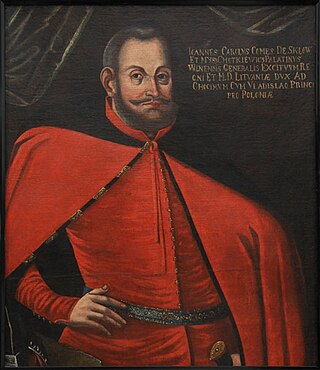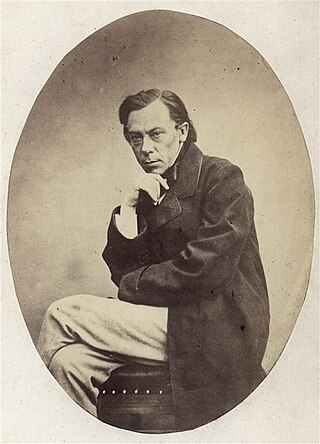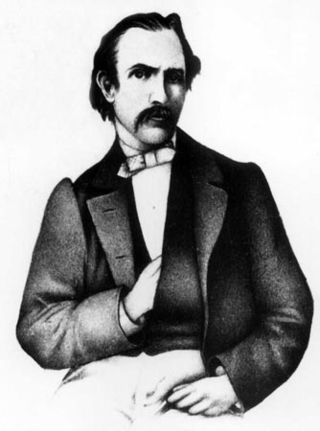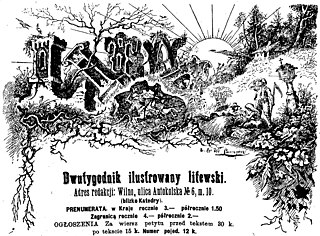
Vilnius is the capital and largest city in Lithuania and the second most populous city in the Baltic states. As of January 2024, Vilnius' estimated population was 602,430, while the Vilnius urban area extends beyond the city limits and had an estimated population of 708,627.

Jan Karol Chodkiewicz was a military commander of the Grand Ducal Lithuanian Army, who was from 1601 Field Hetman of Lithuania, and from 1605 Grand Hetman of Lithuania. He was one of the most prominent noblemen and military commanders of the Polish–Lithuanian Commonwealth of his era. His coat of arms was Chodkiewicz, as was his family name.

The Republic of Central Lithuania, commonly known as the Central Lithuania, and the Middle Lithuania, was an unrecognized short-lived puppet republic of Poland, that existed from 1920 to 1922. It was founded on 12 October 1920, after Żeligowski's Mutiny, when soldiers of the Polish Army, mainly the 1st Lithuanian–Belarusian Infantry Division under Lucjan Żeligowski, fully supported by the Polish air force, cavalry and artillery, attacked Lithuania. It was incorporated into Poland on 18 April 1922.

The Grand Duchy of Lithuania was a European state that existed from the 13th century to the late 18th century, when the territory was partitioned in 1795 among the Russian Empire, the Kingdom of Prussia, and the Habsburg Empire of Austria. The state was founded by Lithuanians, who were at the time a polytheistic nation born from several united Baltic tribes from Aukštaitija.

The coat of arms of Lithuania is a mounted armoured knight holding a sword and shield, known as Vytis. Since the early 15th century, it has been Lithuania's official coat of arms and is one of the oldest European coats of arms. It is also known by other names in various languages, such as Waykimas, Pagaunė in the Lithuanian language or as Pogonia, Pogoń, Пагоня in the Polish, and Belarusian languages. Vytis is translatable as Chase, Pursuer, Knight or Horseman, similar to the Slavic vityaz. Historically – raitas senovės karžygys or in heraldry – raitas valdovas.

The Commission of National Education was the central educational authority in the Polish–Lithuanian Commonwealth, created by the Sejm and King Stanisław II August on October 14, 1773. Because of its vast authority and autonomy, it is considered the first education ministry in European history and an important achievement of the Polish Enlightenment.

Prince Janusz Radziwiłł, also known as Janusz the Second or Janusz the Younger was a noble and magnate in the Polish–Lithuanian Commonwealth. Throughout his life he occupied a number of posts in the state administration, including that of Court Chamberlain of Lithuania, Field Hetman of Lithuania and Grand Hetman of Lithuania. He was also a voivode of Vilna Voivodeship, as well as a starost of Samogitia, Kamieniec, Kazimierz and Sejwy. He was a protector of the Protestant religion in Lithuania and sponsor of many Protestant schools and churches.

Ludwik Władysław Franciszek Kondratowicz, better known as Władysław Syrokomla, was a Polish romantic poet, writer and translator working in Vilnius and Vilna Governorate, then Russian Empire, whose writings were mainly dedicated to the former Grand Duchy of Lithuania. In his writings, Syrokomla called himself a Lithuanian but was disappointed by his inability to speak the Lithuanian language.

Kurier Wileński is the main Polish-language newspaper in Lithuania. Printed in Vilnius, it is the only Polish-language daily newspaper published east of Poland. A direct descendant of both the 19th-century newspaper of the same name and the Czerwony Sztandar newspaper, created by the Soviet authorities in 1953 as a means of Sovietization of the Polish diaspora left in the Polish areas annexed by the Soviet Union. The newspaper is a member of the European Association of Daily Newspapers in Minority and Regional Languages (MIDAS). According to TNS Gallup media research, Kurier Wileński 36,800 people or 1.4% of Lithuania's population read at least one issue out of the last six in summer 2008, but that measure dropped to 0.3% in spring 2010.

The Catholic Church in Lithuania is part of the worldwide Catholic Church, under the spiritual leadership of the Pope in Rome. Lithuania is the world's northernmost Catholic majority country. Pope Pius XII gave Lithuania the title of "northernmost outpost of Catholicism in Europe" in 1939.

Lithuania proper refers to a region that existed within the Grand Duchy of Lithuania where the Lithuanian language was spoken. The primary meaning is identical to the Duchy of Lithuania, a land around which the Grand Duchy of Lithuania evolved. The territory can be traced by Catholic Christian parishes established in pagan Baltic lands of the Grand Duchy of Lithuania subsequent to the Christianization of Lithuania in 1387. Lithuania proper was always distinguished from the Ruthenian lands since the Lithuanians differed from the Ruthenians in their language and faith. The term in Latin was widely used during the Middle Ages and can be found in numerous historical maps until World War I.

Antoni Tyzenhauz was a noble from the Tyzenhaus family, son of Benedykt Tyzenhauz. As a personal friend of Stanisław August Poniatowski, the King of Poland and Grand Duke of Lithuania, Tyzenhaus became Treasurer of the Grand Duchy of Lithuania and administrator of royal estates. He began to implement various agricultural reforms and pioneered industrialization in an effort to increase productivity and economic power of the Polish–Lithuanian Commonwealth. At first, he was successful and managed to gain considerable political influence; he was considered to be the second man after the King. However, the efforts were based on the old system of serfdom and failed. Eventually, amidst increasing political rivalry with other nobles and mounting debts, Tyzenhauz was accused of fraud and removed from public offices in 1780.

The Vilnius Voivodeship was one of the Grand Duchy of Lithuania's voivodeships, which existed from the voivodeship's creation in 1413 to the destruction of the Lithuanian state in 1795. This voivodeship was Lithuania's largest, most politically and economically important.

Mikalojus Akelaitis was a Lithuanian writer, publicist and amateur linguist, one of the early figures of the Lithuanian National Revival and participant in the Uprising of 1863.

The Jesuit College in Polotsk was a college established by the Jesuit Order in Polotsk, then part of the Grand Duchy of Lithuania and later occupied by the Russian Empire, and now in Belarus. It was established in 1580 and continued to function until 1820 when Jesuits were banished from the Russian Empire.

The Józef Zawadzki printing shop was a family-owned printing shop operating in Vilnius from 1805 to 1939. It was established by Józef Zawadzki who took over the failing printing press of Vilnius University established in 1575. It was one of the largest and most prominent printing presses in Vilnius. Until 1828, it had the exclusive rights to publish university publications. It published numerous books and periodicals in Polish, Latin, Lithuanian. It suffered difficulties due to Russification policies that closed Vilnius University in 1832 and banned Lithuanian press in 1864, but recovered after the restrictions were lifted due to the Russian Revolution of 1905. After World War I, it had difficulty competing with the larger printing presses in Poland. The press was sold to a Lithuanian company Spindulys in 1939 and nationalized by the Lithuanian Soviet Socialist Republic in 1940. After World War II, the press was transferred to the communist daily Tiesa.

The Museum of Antiquities in Vilnius was a museum of archaeology and history established by Count Eustachy Tyszkiewicz in 1855 at the premises of the closed Vilnius University. It was the first public museum in the former Grand Duchy of Lithuania and is considered a predecessor of the National Museum of Lithuania even though only a handful of items from the Museum of Antiquities ended up at the National Museum. Together with the Archaeological Commission which functioned as a de facto learned society, the museum was the most prominent cultural and scientific institution in all of Lithuania and displayed many historical items that reminded of the old Grand Duchy and served romantic nationalism of Lithuanian nobles at the time when Lithuania was part of the Russian Empire. The museum collections rapidly grew to over 67,000 items in 1865 by absorbing large collections of minerals and zoological specimens from the closed Vilnius University, libraries of various closed Catholic churches and monasteries, and various donations from local nobles.
The 1st Lithuanian Vanguard Regiment was a military unit of the Grand Duchy of Lithuania. The full name was 1st Advance Guard Regiment of HM the Grand Duke of Lithuania.

Litwa (transl. Lithuania) was a Polish-language newspaper edited and published by Mečislovas Davainis-Silvestraitis in Vilnius, then part of the Russian Empire, from July 1908 to May 1914.

The Collegium Nobilium was a Jesuit foundation in Warsaw between 1752 and 1777. It was intended to provide an élite education for the sons of Magnates of Poland and Lithuania, and other leading Szlachta families, likely to run the country or represent it abroad. It is sometimes confused with another longer established educational institution with the same name, run by the Piarists order in the capital.



















